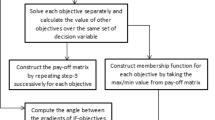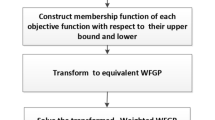Abstract
Several methods have been addressed to attain fuzzy-efficient solution for the multiple objective linear programming problems with fuzzy goals (FMOLP) in the literature. Recently, Jimenez and Bilbao showed that a fuzzy-efficient solution may not guarantee to be a Pareto-optimal solution in the case that one of fuzzy goals is fully achieved. To show this point they employ Guu and Wu’s two-phase approach to obtain a fuzzy-efficient solution first, then a model like a conventional goal programming problem is proposed to find a Pareto-optimal solution. In this study, a new simplified two-phase approach is proposed to find a Pareto-optimal solution for FMOLP without relying on the results of Guu and Wu’s two-phase approach. This new simplified two-phase approach not only obtains the Pareto-optimal solution but also provides more potential information for decision makers. Precisely, decision makers can find out whether the fuzzy goals of objective function are overestimated or not and the amount of overestimation can easily be computed if it exists.
Similar content being viewed by others
Explore related subjects
Discover the latest articles, news and stories from top researchers in related subjects.References
Arikan, F., & Güngör, Z. (2007). A two-phase approach for multi-objective programming problems with fuzzy coefficients. Information Sciences, 177, 5191–5202.
Dubois, D., & Fortemps, P. (1999). Computing improved optimal solutions to max-min flexible constraint satisfaction problems. European Journal of Operational Research, 118, 95–126.
Gupta, A. P., Harboe, R., & Tabucanon, M. T. (2000). Fuzzy multiple-criteria decision making for crop area planning in Narmada river basin. Agricultural Systems, 63, 1–18.
Guu, S.-M., & Wu, Y.-K. (1999). Two-phase approach for solving the fuzzy linear programming problems. Fuzzy Sets and Systems, 107, 191–195.
Ignizio, J. P. (1983). Generalized goal programming. Computers and Operations Research, 10(4), 277–289.
Ignizio, J. P., & Cavalier, T. M. (1994). Linear programming. Singapore: Prentice-Hall.
Jimenez, M., & Bilbao, A. (2009). Pareto-optimal solutions in fuzzy multi-objective linear programming. Fuzzy Sets and Systems, 160, 2714–2721.
Lai, Y. J., & Hwang, C. L. (1994). Fuzzy multiple objective decision making methods and applications. Berlin: Springer.
Lee, E.-S., & Li, R.-L. (1993). Fuzzy multiple objective programming and compromise programming with Pareto optimum. Fuzzy Sets and Systems, 53, 275–288.
Özgen, D., Önüt, S., Gülsün, B., Tuzkaya, U. R., & Tuzkaya, G. (2008). A two-phase possibilistic linear programming methodology for multi-objective supplier evaluation and order allocation problems. Information Sciences, 178, 485–500.
Qu, B. Y., & Suganthan, P. N. (2010). Multi-objective evolutionary algorithms based on the summation of normalized objectives and diversified selection. Information Sciences, 180, 3170–3181.
Ripon, K. S. N., Kwong, S., & Man, K. F. (2007). A real-coding jumping gene genetic algorithm (RJGGA) for multi-objective optimization. Information Sciences, 177, 632–654.
Sahoo, B., Lohani, A. K., & Sahu, R. K. (2006). Fuzzy multi-objective and linear programming based management models for optimal land-water-crop system planning. Water Resources Management, 20, 931–948.
Sakawa, M. (1993). Fuzzy sets and interactive multi-objective optimization. New York: Plenum.
Silva, R. C., & Yamakami, A. (2011). The use of possibility theory in the definition of fuzzy Pareto-optimality. Fuzzy Optimization and Decision Making, 10(1), 11–30.
Tanaka, H., Okuda, T., & Asai, K. (1974). On fuzzy mathematical programming. Journal of Cybernetics, 3, 37–46.
Tavakkoli-Moghaddam, R., Rahimi-Vahed, A., & Mirzaei, A. H. (2007). A hybrid multi-objective immune algorithm for a flow shop scheduling problem with biobjectives: weighted mean completion time and weighted mean tardiness. Information Sciences, 177, 5072–5090.
Wang, R. C., & Liang, T. F. (2004). Application of fuzzy multi-objective linear programming to aggregate production planning. Computers and Industrial Engineering, 46, 17–41.
Wang, Y., & Yang, Y. (2009). Particle swarm optimization with preference order ranking for multi-objective optimization. Information Sciences, 179, 1944–1959.
Wu, H.-C. (2003). Saddle point optimality conditions in fuzzy optimization problems. Fuzzy Optimization and Decision Making, 2(3), 261–273.
Wu, H.-C. (2009). The Karush-Kuhn-Tucker optimality conditions for multi-objective programming problems with fuzzy-valued objective functions. Fuzzy Optimization and Decision Making, 8(1), 1–28.
Xu, J. P., & Liu, Y. G. (2008). Multi-objective decision making model under fuzzy random environment and its application to inventory problems. Information Sciences, 178, 2899–2914.
Zenga, X., Kanga, S., Li, F., Zhangc, L., & Guoa, P. (2010). Fuzzy multi-objective linear programming applying to crop area planning. Agricultural Water Management, 98, 134–142.
Zhou, H. C., Peng, H., Zhang, C., & Xiao, J. M. (2007). Optimization and evaluation of multi-objective crop pattern based on irrigation water resources allocation. Transactions of the CSAE, 23(9), 45–49.
Zimmermann, H.-J. (1985). Applications of fuzzy set theory to mathematical programming. Information Sciences, 36, 29–58.
Zimmermann, H.-J. (1976). Description and optimization of fuzzy systems. International Journal of General Systems, 2, 209–215.
Acknowledgments
This work was supported in part by the National Science Council under Grants no. NSC 100-2410-H-238-008 and NSC 100-2115-M-238-001.
Author information
Authors and Affiliations
Corresponding author
Rights and permissions
About this article
Cite this article
Wu, YK., Liu, CC. & Lur, YY. Pareto-optimal solution for multiple objective linear programming problems with fuzzy goals. Fuzzy Optim Decis Making 14, 43–55 (2015). https://doi.org/10.1007/s10700-014-9192-2
Received:
Accepted:
Published:
Issue Date:
DOI: https://doi.org/10.1007/s10700-014-9192-2




